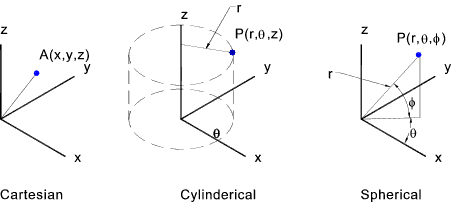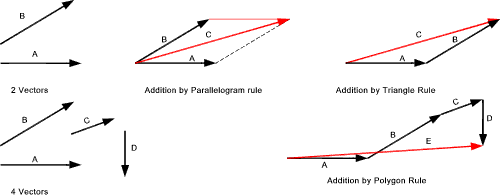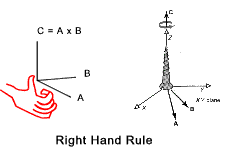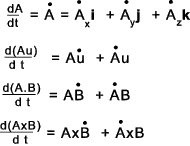Introduction
At the most basic level in mechanics we deal with displacements, velocities, accelerations and forces.
A vector quantity is a quantity which is fully described by both magnitude and direction.
A scalar quantity is a quantity which is fully described by its magnitude. Examples of vector
quantities include displacement, velocity, acceleration, force and moments.
Vector quantities are often represented by scaled vector diagrams.
Vector diagrams depict a vector by use of an arrow drawn to scale in a specific direction.
Vectors are used to depict the forces acting upon an object; such diagrams
are known as free-body diagrams.
Co-ordinate systems
When completing one dimensional work only magnitude and direction is required
e.g 5 miles along a road
north.
For two dimensional systems on plane surfaces, two co-ordinate systems are available.
- The Cartesian System with an horizontal (x) axis and a vertical (y) axis
- The Polar Co-ordinate System with a radius (r) and an angle θ from the x axis in the direction of the y axis
|
For other surfaces the above co-ordinate systems are suitably adapted. e.g. a sphere
can have Latitude and Longitude.
For Three dimensional systems three co-ordinate systems are available
- The Cartesian System with an horizontal (x) axis and a vertical (y) axis and
a projecting (z) axis
- The Cylinderical Co-ordinate System with a radius (r) and an
angle θ from the x axis towards the y axis
and a z co-ordinate (length of cylinder)
- The Spherical Co-ordinate System with a radius (r) and an angle
θ from the x axis towards the y axis and angle
f from the xy plane towards the z axis

|
Vectors
A vector has magnitude and direction. A free vector is not defined as regards
position. A localised vector is defined relative to the co-ordinate origin.
Vectors can be manipulated graphically or using algebraic methods. Generally for
2 dimensional work graphical solutions are more convenient. For 3 dimensional work
it is more convenient to use algebra.
Graphical Methods
Typical methods of adding vectors are shown below..

Two or more vectors are added to form a RESULTANT. A single vector can be replaced
by separate vectors called COMPONENTS by RESOLUTION of the vector.
The figure above shows how vectors can be obtained, using different methods, to obtain
resultant vectors. It is clearly possible to derive component
vectors from a single vector..
Algebraic Methods
It is convenient to represent a vector as a single bold letter e.g. A.
It is also convenient to separate the magnitude of the vector from its direction.
This is done by use of a unit vector e.g. e which has unit magnitude and has
direction. A is then written as Ae. The modulus A written as | A | is the size of the vector and is positive.
In the cartesian co-ordinates the unit vectors in the x,y & z directions are identified as i, j & k.
Therefore a vector A can be broken down into its components...
A = A x i + A y j + A z k<
The modulus | A | 2 = A x2 + A y2 + A z2
Adding two vectors A + B is conveniently done by adding the components
in the x, y, & z directions.
A + B =
(A x + B x) i + (A y+ B y) j +
(A z + B z ) k.
It is clear that for free vectors A + B = B + A
Multiplying a vector by a scalar does not alter it direction.
x .A = x. A x i + x. A y j + x. A z k
The scalar product of two vectors A and B is formally defined as |A| .|B|
Cos θ where θ is the smallest
angle between the vectors..
....An example of a scalar product is when an angled force moves a load. The work don
is the scalar product of the vector of the force and the vector of the distance moved by the load
The cross product of two vectors A and B is formally defined as |A| x |B|
Sin θ where θ is the smallest angle between the vectors... The resultant vector
is in a direction orthogonal to plane of containing the two manipulated vectors as defined by the right hand rule.
.... An example of a cross product is when a couple results from applying a force at a distance from a point. The resulting
torque is identified vectorially as the cross product of the force and distance vectors.
|

The right-hand rule states that the orientation of the vectors'
cross product is
determined by placing A and B tail-to-tail, flattening the right hand,
extending it in the direction of A, and then curling the fingers in the
direction that the angle B makes with A.
The thumb then points in the direction of A x B.
|
To consider a cross product in cartesian co-ordinate form
A x B = (Ax i + Ay j + Az k ) x
(Bx i + By j + Bz k )
It can be proved that
i x j = k = - j x i
j x k = i = - k x j
k x i = j = - i x k
i x i = j x j = k x k = 0
This reduces the cross product to
A x B = (A y . B z — Az . B y).i +
(A z . B x — A x . B z).j +
(A x . B y — A y . B x).k
This is most compactly expressed as a determinant

General Notes on Vector Operations
Commutative Operations ..... A + B + C = B + C + A = C + B + A
Associative Operations.... (A + B) + C = A + (B + C)
Distributive Operations.... a.(A + B + C) = a.A + a.B + a.C
Triple Scalar Products....
(AxB).C = C.(AxB).. Note . Brackets are really not necessary..
Triple Vector Products.... (AxB)xC = -Cx(AxB)= Cx(BxA)...Note .Brackets and essential
The following relationships are provided
AxB)xC = C.AB - C.BA
Ax(BxC) = A.CB - A.BC... Note:..A.CBis interpreted as a scalar dot product A.C multiplied by a vector B
Differentiation of Vectors
In general the differentiation of vectors follows the same rule as the differentiation
of scalar quantities.

| 



